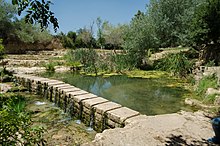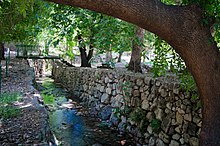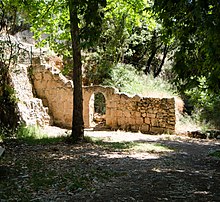Ein Hemed
Archaeological investigations indicate that it was built circa 1140–1160, during the reign of Fulk of Jerusalem, in the same period as the fortresses on Tzova and Abu Ghosh.
The village was depopulated in 1948 (its inhabitants returning to create Ein Naqquba in 1962) and was replaced by the moshav of Beit Nekofa.
In 1925, an American Jew named Isaac Segal Feller purchased a plot of 600 dunams on a hill above the springs.
[11] The cemetery includes the grave of Sheikh Abdullah, in whose honour the oak and terebinth trees in the nature reserve were never cut down.
Four layer springs issue from the riverbed and nearby caves, and unite into a flow of water which continues for about 400 metres.









